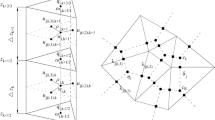Abstract
Wave energy from the ocean is currently a very popular renewable energy, and its development has primarily focused on the shape of the wave energy converter (WEC) used to efficiently convert wave energy into electrical energy. However, the free surface ocean wave problem is very complex and the parameters affecting WEC behavior are difficult to understand. In this paper, based on the Lattice-Boltzmann method, we present particle-based CFD simulation results for the pivoted-type WEC that exhibits both vertical and horizontal motions. In this method, the computation domain need not be a mesh and complex geometry is not a limiting factor. Using a free-surface turbulence model, we simulated the fluid–structure interaction. We detail our simulation results, which show good agreement with those in the literature.











Similar content being viewed by others
References
Bhinder MA, Mingham CG, Causon DM, Rahmati MT, Aggidis GA, Chaplin RV (2009) Numerical modelling of a surging point absorber wave energy converter. Proceedings of the 8 th European Wave and Tidal Energy Conference, Uppsala, Sweden. https://doi.org/10.1115/OMA2009-79392
Choi K-S, Yang D-S, Park S-Y, Cho B-H (2012) Design and performance test of hydraulic PTO for wave energy converter. Int J Precis Eng Manuf 13(5):795–801. https://doi.org/10.1007/s12541-012-0105-4
Clément AH, McCullen P, Falcão A, Fiorentino A, Gardner F, Hammarland K, Lemonis G, Lewis T, Nielsen K, Petroncini S, Pontes MT, Schild P, Sjöström BO, Sorensen HC, Thorpe T (2002) Wave energy in europe: current status and perspectives. Renew Sust Energ Rev 6:405–431. https://doi.org/10.1016/S1364-0321(02)00009-6
Coiro DP, Troise G, Calise G, Bizzarrini ( N (2016) Wave energy conversion through a point pivoted absorber: Numerical numerical and experimental tests on a scaled model. Renew Energy:317–325. https://doi.org/10.1016/j.renene.2015.10.003
Drew B, Plummer AR, Sahinkaya MN (2009) A review of wave energy converter technology. Proc. IMechE, Part A: J. Power and Energy. https://doi.org/10.1243/09576509JPE782
Gonzalez CA, Kloos G, Finnigan T (2009) Development of a multi-bladed 250 kW pitching wave-energy converter. Proceedings of the 8th European Wave and Tidal Energy Conference, Uppsala, Sweden.
Griet De Backer (2009) Hydrodynamic design optimization of wave energy converters consisting of heaving point absorbers, Doctor Dissertation, Ghent University, Belgium. www.vliz.be/imisdocs/publications/220173.pdf
Holman DM, Brionnaud RM, Abiza Z (2012) Solution to industry benchmark problems with the lattice-Boltzmann code XFlow, ECCOMAS.
Ka Sing Kane Lok, 2010. Optimisation of the output of a heaving wave energy converter, PhD thesis, University of Manchester.
Kalofotias F (2016) Study for the hull shape of a wave energy converter-point absorber. Master thesis, University of Twente, Netherlands.
Kelly S (2007) Hydrodynamic optimisation of a point wave- energy converter using laboratory experiments, Thesis, The University of Auckland, New Zealand.
Marquis L, Kramer MM, Kringelum J, Chozas JF, Helstrup NE (2012) Introduction of wavestar wave energy converters at the Danish offshore wind power plant Horns Rev 2. 4 th International Conference on Ocean Energy, 17 October, Dublin.
McCormick ME, Ertekin CR (2009) Renewable sea power: waves, tides, and thermals new research funding seeks to put them to work for us. ASME Mech Eng 131(5):36–39. https://doi.org/10.1115/1.2009-MAY-4
Mueller MA, Henk Polinder, Nick Baker (2007) Current and novel electrical generator technology for wave energy converters, 2007 IEEE International Electric Machines & Drives Conference, 1401–1406. https://doi.org/10.1109/IEMDC.2007.383634
Next Limit Dynamics SL, 2016a. XFlow 2016 Theory guide.
Next Limit Dynamics SL, 2016b. XFlow 2016 User guide.
Plummer AR, Schlotter M (2009) Investigating the performance of a hydraulic power take-off. Proceedings of the 8th European Wave and Tidal Energy Conference, Uppsala, Sweden.
Ruud Kempener, Frank Neumann (2014) Wave energy technology brief. IRENA Ocean Energy, Technology Brief 4.
Salter SH, Jeffery DC, Taylor JRM (1976) The architecture of nodding duck wave power generators. Nav Archit 1:21–24
Sarlak H, Seif MS, Abbaspour M (2010) Experimental investigation of offshore wave buoy performance. Journal of Marine Engineering, 6(11), Spring & Summer.
Van den Berg J, Ricci P, Santos M, Rico A, Lopez J (2010) Hydrodynamic performance of heaving wave energy converters in wave climates. 3 rd International Conference on Ocean Energy, 6 October, Bilbao.
Xiao Cui (2014) Study of power decoupling properties of hydraulic power take-off system in ocean wave converter. 2014 4th International Conference on Future Environment and Energy, IPCBEE. https://doi.org/10.7763/IPCBEE . 2014. V61. 18
Li Ye, Yu Yi-Hsiang (2012) A synthesis of numerical methods for modeling wave energy converter-point absorbers. National Renewable Energy Laboratory (NREL), NREL/JA-5000-52115
Yodchai Tiaple, Surasak Phoemsapthawee, Phansak Iamraksa, Wanlee Noenmosi, Nontiphat Taweewat (2013) Study and research to develop wave energy converter for Thailand, Report (in Thai).
Yu YH, Jenne DS, Thresher R, Copping A, Geerlofs S, Hanna LA (2015) Oscillating surge wave energy converter, Technical Report, National Renewable Energy Laboratory (NREL), January.
Zanuttigh B, Angelelli E, Kofoed JP (2013) Effects of mooring systems on the performance of a wave activated body energy converter. Renew Energy 57:422–431. https://doi.org/10.1016/j.renene.2013.02.006
Funding
The project is sponsored by the Energy Policy and Planning Office, Ministry of Energy, Thailand (Contract No. 07-02-57-014).
Author information
Authors and Affiliations
Corresponding author
Additional information
Article Highlights
• A particle-based CFD based on the Lattice–Boltzmann method allows there to be no limitation on the complexity of the model and is also suitable for moving model.
• The hydrodynamic simulations for the pivoted WEC can predict its performance which is consistent with the experimental results reported in the literature.
• The energy conversion efficiency of the pivoted floating buoy is quite high compared to with the pure heave motion of the WEC.
Rights and permissions
About this article
Cite this article
Tiaple, Y. Hydrodynamic Simulation of Wave Energy Converter Using Particle-Based Computational Fluid Dynamics. J. Marine. Sci. Appl. 18, 48–53 (2019). https://doi.org/10.1007/s11804-019-00070-0
Received:
Accepted:
Published:
Issue Date:
DOI: https://doi.org/10.1007/s11804-019-00070-0



